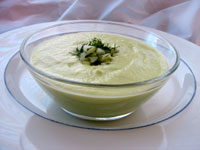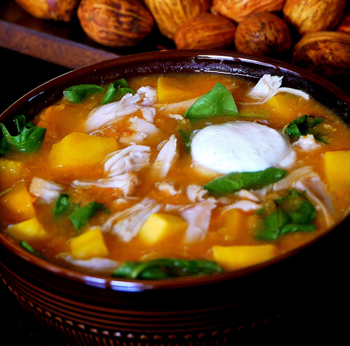 Last Summer I spent my birthday up in the Napa valley. I stayed at a spa, went wine tasting and ate out, of course. It was sunny and relaxing and just a little bit indulgent. I had a terrific time and especially terrific meals, the highlight of which was a cool creamy soup at chef Douglas Keane's restaurant Market, in St. Helena.
Last Summer I spent my birthday up in the Napa valley. I stayed at a spa, went wine tasting and ate out, of course. It was sunny and relaxing and just a little bit indulgent. I had a terrific time and especially terrific meals, the highlight of which was a cool creamy soup at chef Douglas Keane's restaurant Market, in St. Helena.
Frankly the soup ingredients sounded like a spa treatment--yogurt, cucumber, avocado, was it a soup or a facial? Inspired to create my own version I gathered a whole bunch of fresh green ingredients and started experimenting. If your cold soup repertoire consists of gazpacho, try this one on for size. It's a great solution for dinner on a hot night, especially since it can be made in minutes and without heating up the kitchen.
Summer
Summer
A Perfect Summer Salad
 Summer is nearly here. For many Memorial Day weekend marked the beginning of summer with barbecues and backyard parties. And with the hot weather that we on the East coast are already having, it's easy to start entertaining like it's summer. I found myself pulling out the grill for the first time yesterday, and it couldn't have happened any sooner. My oven will be on hiatus for the next few months. Right now with the availability of fresh spring salad greens and herbs in farmers' markets, I find myself creating recipes that require little or no cooking. I'm taking every opportunity to use garden-fresh produce, especially herbs.
Summer is nearly here. For many Memorial Day weekend marked the beginning of summer with barbecues and backyard parties. And with the hot weather that we on the East coast are already having, it's easy to start entertaining like it's summer. I found myself pulling out the grill for the first time yesterday, and it couldn't have happened any sooner. My oven will be on hiatus for the next few months. Right now with the availability of fresh spring salad greens and herbs in farmers' markets, I find myself creating recipes that require little or no cooking. I'm taking every opportunity to use garden-fresh produce, especially herbs.
One in particular is my favorite as well as the most utilized herb of many cuisines. Parsley, what would Mediterranean and Middle Eastern cooking be without it? You might only know parsley as a sprig of green that garnishes food. But one of the best uses for parsley as a main ingredient is the popular Lebanese dish of tabbouleh. Served in many Mediterranean restaurants and even supermarket salad bars, it's no stranger to American palates. It's a refreshing salad typically served alongside Middle Eastern appetizers called mezze. It can also be very versatile, making a great summer salad to eat with grilled meats.
Eggplant 101: How to Select, Store, and Cook Them
 Of all the fabulous and quirky names out there such as aubergine, brinjal, melanzane, and egg apple, we had to go with "eggplant." It's such a dull name to describe such a singular vegetable. (Botanically, it's a fruit, but we all use it as a vegetable, so let's go with that.)
Of all the fabulous and quirky names out there such as aubergine, brinjal, melanzane, and egg apple, we had to go with "eggplant." It's such a dull name to describe such a singular vegetable. (Botanically, it's a fruit, but we all use it as a vegetable, so let's go with that.)
Why "eggplant"? Apparently some 18th century European cultivars resembled goose or hen's eggs, so planters called them "eggplants."
Eggplants have a long history. They are native to India where they were first cultivated over 4,000 years ago. During the Middle Ages Arabs introduced eggplant to the Mediterranean region. Eventually European explorers introduced eggplant to places such as Africa and North America. Today China, India, and Egypt are the world's leading producers of eggplant.
Eggplants are available year-round in most major supermarkets, but they are best during August-October, their prime growing season. So here are some tips on how to select, store, and cook with eggplant:
Strawberry Mascarpone Tart
 Strawberries, the most popular berry fruit, are in high season right now and I'm thoroughly enjoying eating them every which way. Strawberries have always been a special part of summer for me. I can hardly remember a summer that I didn't go strawberry picking with my family. At the pick-your-own farm we would eat them right off the bush. Their flavor is so concentrated when eaten warm, heated by the sunlight. Now I don't so much eat them off the bush, but instead try to come up with new ways to serve the fruit.
Strawberries, the most popular berry fruit, are in high season right now and I'm thoroughly enjoying eating them every which way. Strawberries have always been a special part of summer for me. I can hardly remember a summer that I didn't go strawberry picking with my family. At the pick-your-own farm we would eat them right off the bush. Their flavor is so concentrated when eaten warm, heated by the sunlight. Now I don't so much eat them off the bush, but instead try to come up with new ways to serve the fruit.
This summer I decided to make a tart instead of the traditional strawberry pie. This tart features a sweetened mascarpone cheese base, topped with macerated fresh strawberries, all glazed with a syrup of the reserved berry juices and a touch of balsamic vinegar. Except for the tart shell, there is no baking involved. So it's very easy to put together for a family party, picnic, or the upcoming fourth of July holiday. Celebrate summer with strawberries.
Raw Corn Takes Centerstage
 Where would I be without California farmers? If it weren't for them, I would never have discovered the sticky, caramel bliss of Medjool dates, the tropical pina colada flavors of cherimoya, or the simple joy of munching on raw summer sweet corn. Yes, raw corn.
Where would I be without California farmers? If it weren't for them, I would never have discovered the sticky, caramel bliss of Medjool dates, the tropical pina colada flavors of cherimoya, or the simple joy of munching on raw summer sweet corn. Yes, raw corn.
At first, I was skeptical. Having grown up in New England, I was accustomed to bright yellow, fat kerneled ears of corn steamed to perfection and doused with melted butter and salt. But the LA farmer insisted I taste the raw corn he was offering: raw, white, small kerneled corn. How could such puny corn possibly be good without butter and salt?
Still, I held out my palm while he filled it with a scoop of raw corn kernels. With one swift swoop of the arm, I popped the entire handful in my mouth. It was crunchy, as in snap! crackle! pop! crunchy and surprisingly juicy. As for the flavor, well, it was natural. Just unadorned, mildly sweet, old-fashioned corn flavor. I was hooked.
More Articles ...
Welcome to the new One for the Table ...
Our Home Page will be different each time you arrive.
We're sure you'll find something to pique your interest...

